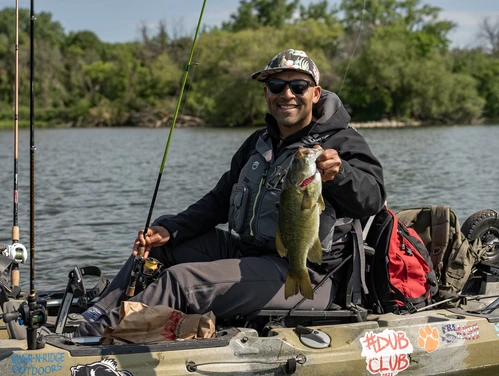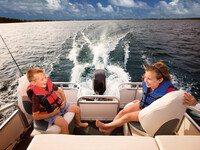Back to top
Tips for a Fun, Safe Kayak Fishing Adventure
Fishing from a kayak is an active way to get close with nature. Kayaks are small, quiet and more maneuverable than any other boat. Plus, you can get close to shore where other boaters rely on less accurate, long distance casting. Try these tips to get you started:
- Travel light. Leave your packed tackle box at home. Bring only the basic tackle you need for the specific fish species you are trying to catch.
- Be confident. Make sure you are confident paddling before you load your kayak with fishing gear. Learn the basic paddling strokes and how to rescue yourself if needed. Hands-on instruction and online paddling safety courses are available.
- Stay safe. Check water levels and weather conditions before you go. Fish with a buddy and let someone know where you’re going. Wear a properly-fitted life jacket and bring along a basic first aid kit. Carry your cell phone in a water tight dry-bag for emergencies. Never paddle when lightning is in the area.
- Go with the flow. If you’re on a lake with a light breeze or a current, start fishing the shoreline on its windward side and let it push you down the shoreline.
- Stay hydrated. Bring along plenty of water to drink. Wear light, loose fitting clothing that dries quickly. Make sure you have a hat, good sunglasses and plenty of sunscreen.
- Be cautious of your surroundings. Stay well downstream of any low head dams. Use caution fishing around wood debris (strainers) on the outside bends of smaller fishing streams. Be careful paddling around obstructions - new snags, log jams, submersed logs and other debris.
- Get an appropriately sized anchor. Major sporting goods retailers sell specialty kayak anchors that have a folding “claw” system for a better hold in current or winds. Look for an anchor that weighs about 10 pounds or less. Most kayaks move at the slightest breeze or even from your casting motion. An anchor is helpful when you want to lock in your position so you can continually cast into a school of fish or a piece of cover/structure.
- Secure your gear. Tie down your paddle, tackle box and other fishing necessities to avoid losing them.
- Use your strengths. Kayaks are smaller, quieter, and more maneuverable than almost any other boat on the water. Head deep into the flooded timber on a relatively new reservoir (e.g., Brushy Creek or Twelve Mile Creek Lake). Get close to shore in areas where other boats have to rely on less accurate, long distance casting.
Sign up for the weekly fishing report to find out what’s biting where. For more ideas and maps, visit our water trails pages or our Iowa Fishing and Iowa Paddling boards on Pinterest.
Back to topClean. Drain. Dry.
You can help stop the spread of aquatic invasive species by following these easy steps everytime you explore Iowa waters.
- Clean: When you get your kayak out of the water, inspect it to make sure there are no plants, mud or debris on or in it, the paddles, and any equipment or trailer. If you find anything, remove it and dispose of it in the trash or on dry land away from water before moving to a new location.
- Drain: Make sure there is no standing water in your kayak. Tip it upside down to make sure there isn’t any water in the bottom. Make sure your bait buckets and internal compartments are clean and dry as well.
- Dry: Use a rag or towel to dry your vessel including all compartments, livewells, and bait buckets, as well as your anchor (if applicable). If possible, dry everything for five or more days. Most aquatic invasive species can only survive in wet conditions, so this is one of the best ways to help prevent their spread.
Getting Started
Anyone 16 years and older must have a fishing license to fish Iowa waters.
- Fishing in Iowa
- Fish Local
- Fishing Basics
- Iowa Interactive Paddling Map
- Iowa Water Trail Maps
- Plan Your Paddling Adventure
- How to Select Kayak Fishing Gear
Know Before You Go
- Fishing Regulations
- Paddling Regulations
- Real-time Streamflow and Levels (USGS)
- Iowa Fishing board on Pinterest
- Follow us on Twitter/X for fishing updates

